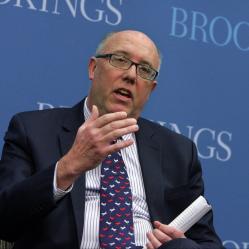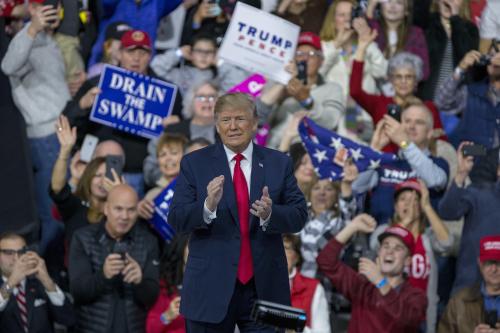In Unpacked, Brookings experts provide analysis of Trump administration policies and news.
The issue:
Shortly after President Trump visited Saudi Arabia for a summit with Islamic leaders, the Saudi government announced that they would cut diplomatic ties with neighboring Qatar. The Trump administration initially supported the Saudi blockade on Qatar, but now seeks to bring unity back to the divided region.
The dispute between Saudi Arabia and Qatar has now reached a peak. Just a month after a summit that brought Islamic leaders together, there is now a display of disunity in the Arab and Muslim world.
The things you need to know:
- President Trump chose Saudi Arabia for his first foreign visit, which attests to the importance of the kingdom for American foreign policy particularly in the Middle East, but also more broadly in the Islamic World.
- During the visit, the Trump administration and Saudi government announced the creation of a 50-nation alliance to fight terrorism and contain Iranian subversion. They also announced some very large arms deals and civilian deals, much of which were aspirational.
- The Trump administration announced a $110 billion arms deal with Saudi Arabia, which doesn’t actually exist. There are however, aspirations for the United States to sell as much as $110 billion in arms over the course of Trump’s presidency.
- The Saudis were able to convene more than 50 Islamic leaders to the summit with President Trump. The leaders all agreed that they wanted to fight the Islamic State and al-Qaeda. They also agreed that Iran was a source of problems in the region, although not all 50 leaders were as enthusiastic about confronting Iran as Saudi Arabia and Donald Trump seemed to be.
- Unfortunately, within a fortnight after the visit, the Saudis decided to blockade and ostracize their small neighbor Qatar instead of Iran.
- Much of the unity from the summit has since splintered and fallen apart. Turkey and Iran have backed Qatar, while the United Arab Emirates and Egypt back Saudi Arabia. Other countries, like Pakistan and Oman, are trying to remain neutral.
- Following the summit that brought various Islamic leaders together, there is now a display of disunity in the Arab world and Muslim world more broadly. This disunity is rooted in a secondary issue: How Qatar interacts with its neighbors.
- Saudi Arabia is a leader in the Gulf Cooperation Council (GCC), which was created in the 1980s to bring all of the monarchies in the Gulf together. The Saudis always viewed themselves at the helm of the GCC, but the Qataris wanted it to be independent.
- This dispute between Saudi Arabia and Qatar has been occurring for 20 years, but it’s now reached a peak. Never before have some Gulf countries actually laid siege against another.
- This could be the end of the GCC, which has been a principle mechanism for the United States to bring together its friends in the Middle East since the 1980s.
- If this clash can’t be mended or repaired, we’re going to see a much more divided Gulf with more opportunity for Iran to meddle in the affairs of the region. This division is a self-inflicted wound by the Saudis.
- The Trump administration, after some initial confusion, looks like it’s trying very hard to see if it can put humpty dumpty back together again, but that’s going to be difficult to do.
The sources:
On Saudi Arabia breaking ties with Qatar
The $110 billion arms deal to Saudi Arabia is fake news



Commentary
Saudi Arabia, Qatar, and a divided Gulf
July 11, 2017